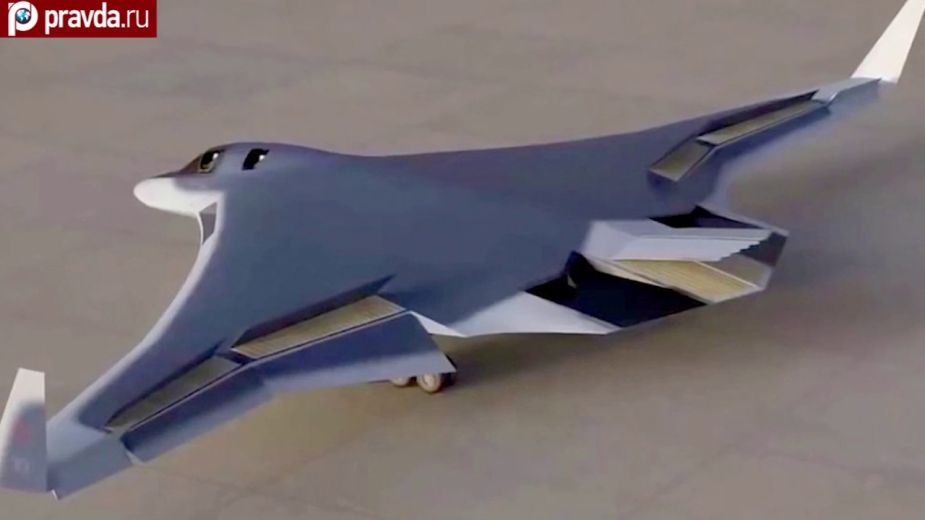Breaking news
Russia began to create new strategic bomber PAK DA.
Russia began to create Prospective Airborne Complex of Long-Range Aviation (PAK DA) which is to replace Tu-95MS and Tu-22M3 bombers, Gazeta.ru online publication writes about requirements to the prospective strategic bomber.
 Drawing of new Russian PAK DA Prospective Airborne Complex of Long-Range Aviation strategic bomber. (Picture source Pravda print screen Youtube)
Drawing of new Russian PAK DA Prospective Airborne Complex of Long-Range Aviation strategic bomber. (Picture source Pravda print screen Youtube)
The leading Russian Tupolev producer of strategic bombers and other enterprises of the United Aircraft Corporation (UAC) began preparations to create PAK DA. In February 2019, the concept of the long-range bomber was finally determined and contracts signed to begin production.
According to official data, the new strategic bomber will have the flying wing aerodynamic scheme and stealth technologies. It will be a subsonic aircraft.
In 2009, the Tupolev Design Bureau signed a contract with the Defense Ministry for Poslannik R&D which produced the rough design of PAK DA. The new bomber has been designed since 2013. Then Deputy Defense Minister Yuri Borisov said PAK DA can make the maiden flight in 2025-2026 and the batch production was scheduled in 2028-2029. He said the bomber has to carry as many weapons as possible, be invisible and use any airfield.
PAK DA will be armed with hypersonic weapons. Its main mission is to deliver low-signature precision missiles to the launch site located several thousand kilometers from adversary targets. Stealth characteristics of the bomber are a priority.
"With this aim the glider of the prospective bomber will have a broad range of composite materials and radio-absorbing coatings to decrease the cross-section (titanium is considered). The infrared signature will be decreased by dry-thrust turbojet double-flow engines with flat rectangular nozzles oriented towards the upper hemisphere (the lower nozzle hemisphere is covered by tail lifting elements to decrease the detection range of the engine heat flow by infrared sights of hostile fighter jets and air defense weapons)," said Deputy Director of the Center for Strategy and Technology Analysis Konstantin Makienko.
The contract for the bomber’s engine was signed by the United Engine Corporation (UEC) and the Tupolev Company in June 2018. ODK-Saturn and ODK-STAR of the UEC are also participating.
The tender documentation published by the Kuznetsov enterprise calls to design a turbo starter, automatic controls and diagnostics, a low-pressure compressor and turbine, semiconductor ignition plugs, oil and fuel filters, as well as coded documentation and software to protect state secrets. The design was estimated at 10.1 bln rubles and a half (5.1 bln) will be earmarked to create low-pressure turbine.
The R&D documentation said the engine has to be protected from nuclear explosion aftermath and should operate with minimal capacity losses in air temperatures ranging from minus 60 to plus 50 degrees Centigrade. The engine resource should be at least 8 thousand hours.
Time between overhaul of the power plant should be at least 600 hours, however the exact figure for the engine resource and its units will be determined at acceptance trials. The fuel system of PAK DA must properly supply fuel at close-to-zero and negative overload. The life cycle of the engine should be at least 12 years with a potential extension to 21 years.
The electronic engine system (the main and standby ones) should forecast the state of the unit and its systems to ensure a 30-hour long flight.
In March 2017, the Tupolev created a full-size PAK DA mockup. In May 2017, a digital PAK DA model was ready. The digital equipment allows technical maintenance of the aircraft at all life cycle stages, the United Aircraft Corporation said. In the summer of 2018, it approved the rough design of PAK DA and began the R&D. The Gorbunov affiliate of the Tupolev in Kazan is creating the aircraft.
The navigational system of PAK DA will be linked with satellite signals and orient by astronomic data. It will make the bomber less vulnerable to electronic warfare, Gazeta.ru writes.


























